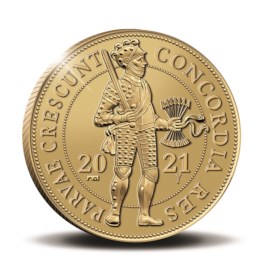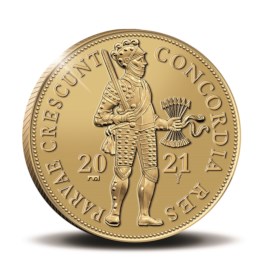
Trade coins in treasure chests
On trade ships, trade coins were found as well. Dutch ships sailed to Asia (among other directions) to trade because Asian spices were in high demand. Asia was however not interested in Dutch trade goods and therefore Gold and Silver, in bars or in the form of coins, were taken to finance these trades. This also drew the attention of pirates and privateers. Rumour has it that every Gold or Silver coin has been in the hands of a pirate at some point during the Golden Age.
Trade coins from the Netherlands
To determine which Dutch trade coins could have been robbed by pirates, it is first of all important to know which coins were present on trade ships. Initially Silver from Latin-America in the form of the Spanish cob was highly wanted in Asia. However, around 1630 Dutch trade coins such as Lion Dollars, Silver Ducats and Ducatons became more important because they had higher values abroad as they were not subjected to the Dutch exchange rates. Golden Ducats were also shipped to Asia in increasing amounts during the 18th century.
Pirate coins
Who is not familiar with the image of overflowing treasure chests filled with Silver and Golden trinkets and above all a large amount of shiny coins. Now that we have determined which coins circulated in international trades we can look into pirate coins.
Although the Golden Ducat was a very important trade coin in the Golden Age, the Dutch Lion Dollar was probably the most widely used Dutch Silver trade coin. Even the restrikes issued by the Royal Dutch Mint each year are for at least 80% intended for international sales. In addition to use in the Dutch colonies of Curacao, Suriname, and St Maarten, the Lion Dollar saw notable circulation in a number of the English colonies, including Maryland, Pennsylvania, New Jersey, New York, East Virginia, and Massachusetts. The original Lion Dollar could surely be considered as a candidate for a pirate coin considering their international circulation in pirate-areas.
Other candidates for “pirate coins” are the Dutch Silver Ducat, the Ducaton: Silver Rider and of course the Golden Ducat. In the period between 1726 and 1751 Silver Riders were issued by the East India Trading Company itself because they were good competition to the Spanish cob. All coins mentioned above have sailed international seas in the areas where piracy and privateers flourished.
As mentioned before, one could argue that almost every Silver or Gold coin from the Golden Age has been in the hands of a pirate at some point. This should however be taken lightly. Historical trade coins that are sold as “pirate coins” do not have any guarantee that they actually were in pirate hands.
Trade coins from the Netherlands
To determine which Dutch trade coins could have been robbed by pirates, it is first of all important to know which coins were present on trade ships. Initially Silver from Latin-America in the form of the Spanish cob was highly wanted in Asia. However, around 1630 Dutch trade coins such as Lion Dollars, Silver Ducats and Ducatons became more important because they had higher values abroad as they were not subjected to the Dutch exchange rates. Golden Ducats were also shipped to Asia in increasing amounts during the 18th century.
Pirate coins
Who is not familiar with the image of overflowing treasure chests filled with Silver and Golden trinkets and above all a large amount of shiny coins. Now that we have determined which coins circulated in international trades we can look into pirate coins.
Although the Golden Ducat was a very important trade coin in the Golden Age, the Dutch Lion Dollar was probably the most widely used Dutch Silver trade coin. Even the restrikes issued by the Royal Dutch Mint each year are for at least 80% intended for international sales. In addition to use in the Dutch colonies of Curacao, Suriname, and St Maarten, the Lion Dollar saw notable circulation in a number of the English colonies, including Maryland, Pennsylvania, New Jersey, New York, East Virginia, and Massachusetts. The original Lion Dollar could surely be considered as a candidate for a pirate coin considering their international circulation in pirate-areas.
Other candidates for “pirate coins” are the Dutch Silver Ducat, the Ducaton: Silver Rider and of course the Golden Ducat. In the period between 1726 and 1751 Silver Riders were issued by the East India Trading Company itself because they were good competition to the Spanish cob. All coins mentioned above have sailed international seas in the areas where piracy and privateers flourished.
As mentioned before, one could argue that almost every Silver or Gold coin from the Golden Age has been in the hands of a pirate at some point. This should however be taken lightly. Historical trade coins that are sold as “pirate coins” do not have any guarantee that they actually were in pirate hands.
Coins of the Dutch Golden Age
Double Golden Ducat 2021
ORDER EXCLUSIVELY IN MAY 2021

Single Golden Ducat 2021
ORDER EXCLUSIVELY IN MAY 2021

